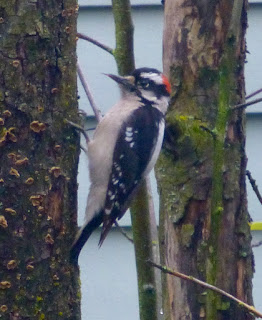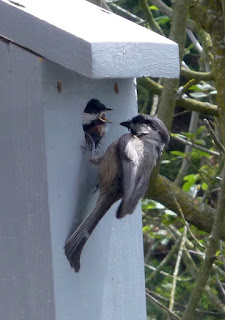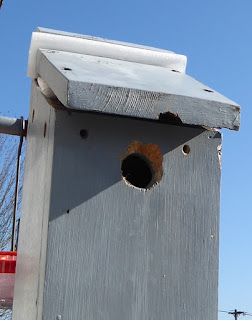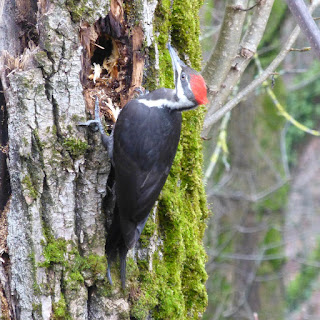 We get used to the sounds of construction around here. Not to mention destruction. You see a perfectly sweet little house on your walk and the next week it’s gone and the week after that it’s been replaced by a way bigger house with way richer people in it. A bunch of folks make a lot of money, the tax base shoots up, a few thousand more people huddle in tents on the freeway ramp, and everyone’s happy. That’s life in modern libertarian America, where there’s still plenty of dough, but it hasn’t all settled evenly.
We get used to the sounds of construction around here. Not to mention destruction. You see a perfectly sweet little house on your walk and the next week it’s gone and the week after that it’s been replaced by a way bigger house with way richer people in it. A bunch of folks make a lot of money, the tax base shoots up, a few thousand more people huddle in tents on the freeway ramp, and everyone’s happy. That’s life in modern libertarian America, where there’s still plenty of dough, but it hasn’t all settled evenly.
It’s lumpy.
The point is, it’s not unusual for me to hear a bunch of hammering. It is surprising when it’s happening on my house. Or, more accurately, Marge and Studley Windowsons’ rental, outside my window. They raise their chilluns in it most every spring, but it’s empty at the moment. That’s okay. For what we charge, it doesn’t really matter if it’s at full occupancy. At all.
 But I hadn’t seen any demolition notices and I was a little taken aback when the downy woodpecker showed up and started whacking away at the front door. This is a concern. According to the literature, chickadees are fussy about their door size. One and a quarter inches. One and a quarter inches. This woodpecker was definitely messing with the template.
But I hadn’t seen any demolition notices and I was a little taken aback when the downy woodpecker showed up and started whacking away at the front door. This is a concern. According to the literature, chickadees are fussy about their door size. One and a quarter inches. One and a quarter inches. This woodpecker was definitely messing with the template.
And I wondered: do downy woodpeckers nest in boxes? If they can get their bodies in? It might seem to normal people that I know a lot about birds, but I don’t. I’m always picking it up on the fly, as it were. Turns out woodpeckers are fine with nesting boxes. But of course this isn’t the time of year they’re likely to be churning out fresh woodpeckers. I read on.
Roosting boxes! I didn’t even know that was a thing. This is one of those big important bird things I knew nothing about, but always wondered: what do they do when it’s really stormy and windy out? And where do they go at night?
 |
| Entry door, post-pecker |
It was particularly breezy yesterday and I watched a few birds on the tippy top branches of a tree that was rocking and rolling. It looked like it could be a lot of bouncy fun, really, although I suppose if you can also fly it might not be such a thrill. One thing I do know. They don’t have to clench their little feetses to stay on a branch. That would be dreadful, trying to get a decent night’s sleep while hanging on for dear life. What we call birds’ feet are just their toes. The part that you think is a knee is their ankle. Their knees are right up near the basic bird silhouette where it starts to get personal. If you can see their hips, you’ve done something rude.
And there’s a tendon that runs along their legs that holds their toes in grabby position. That’s the default. They have to operate the tendon to open their toes, so basically, they’re snap-on, snap-off accoutrements. They’re not likely to fall off a branch; they have to motivate to do that. The hummingbird, which spends every night in a stage of near-death, has even been observed to hang upside-down from a branch while sleeping. So you could set it swinging, if you wanted to. You’d kind of want to, but that would be rude also.
 |
| Bonus woodpecker |
Still, how do they cope with extreme cold and wind and sleet and plagues of frogs? The answer for many is they roost. They get together with their pals and bunch up for warmth in a house or a hole. Some birds roost every night but some just hunker down when it’s icky. Our downy woodpecker might be trying to remodel the Windowson place for winter sleepage.
Apparently the chickadees might occasionally use the old homestead for that too. I’d hate to think of what they’d do if they bombed into the place and found it stuffed with woodpeckers. I’m all for letting Nature take its course but if I see Marge and Studley in a little tent by the freeway, I’m going to intervene.
You can buy birdhouse portal protectors: https://www.springhillnursery.com/product/portal-protectors?p=0439751&pid=62397&gclid=EAIaIQobChMInffKs7vT5wIVyp6zCh0ynw3mEAQYBSABEgI3sfD_BwE
We put them on all our birdhouses because of squirrels trying to chew on the boxes to make them into squirrel nest boxes. Of course, now the squirrels try to chew the roof off, so eventually we will probably replace all our wood boxes with recycled plastic ones.
During cold or foul weather, birds usually congregate on the top ledge of our windows, under the eaves. I can hear their little feet scurrying around there while I am sleeping. It's such a cozy sound.
I self-cheer just thinking about birdie feet.
My favorite woodpecker is the pileated who reminds me of a pteradactyl by its call and way of flying. You can hear them pecking for a long way off. I have never seen one of their homes, but I imagine it would need to be about the size of my Corolla.
Look for a rectangular hole in a tree! They're all about the corners.
There is a pair of downy woodpeckers that feed outside my window everyday. We have named them Robert and Roberta. They are frequently chased away from the feeders by a red-bellied woodpecker that my daughter has named "Asshole." I feel it's a bit extreme. The juncos, chickadees and nuthatches are not afraid of him. And just this week, he brought a lady friend with him for the first time.
I like it when birds wear hats to signify their sex. And if my mother ever heard anyone say "asshole," she didn't hear it from me.
'Course, she's been gone a long time…
We have three types of woodpeckers that come to our feeders: red-bellied, downy, and hairy. We used to have four—red-headed, but too many trees have been bulldozed for yet more developed, and we haven't had redheads in at least ten years now. I miss them!
more development. I wish I could edit my mistakes!
You CAN, by hitting delete which will give you a chance to copy what you have so you can start over. It's clunky. And besides we mentally edit for you and most of the time don't even notice.
I agree with Murr. Most of us read for content and skid right past whatever the poster thinks they did wrongly.
Cop Car
We only get snippy when the commenter is full of shit. Then all of a sudden his typos are REALLY IMPORTANT.
For obvious reasons I have spent of a lot of time this summer thinking about where the critters and birds go when conditions are extreme. And welcome those that hang around here. All of them.
I have been thinking about them too. Almost got a blog post started about it but it makes me too sad.
I still can't fathom how woodpeckers don't all have brain damage, or, at a minimum, headaches. Nope, they're just out there slamming their stabbity bits into hard surfaces. Including our BBQ, one year.
I sincerely hope the Windowsons aren't reduced to a tent, but I feel better knowing you'll be there to help them out if they are.
I wrote a bird book, as yet unpublished, and I addressed this problem of woodpecker brain damage, but I don't remember what I said. I think it had something to do with not having a lot of brainage to begin with.
I know very little about American birds.But I do know why woodies don't suffer brain damage…they have super-tight muscle holding it in place , also something like a compressible bone.Built-in stabiliser/shock absorber thingy.I hope this is not too technical.
They also have a really good anchor in their stiff tails.
Interesting! Thanks, dinahmow.
OK, I did a search in my bird book for this, and this is what I wrote: "The main reason they don’t get headaches is that their children all leave the nest in under a month. But also, their brains are kind of small and jammed up against the skull so that they don’t rattle around too much."
Hah!
A woodpecker's tongue retreats into a channel that wraps around its brain. Sort of like a spring loaded tape measure only apparently bony. We are beginning flicker courting season with male flickers repeatedly drumming on whatever resonates the best. It's pretty wonderful unless it's your roof the guy is using as a bingo drum.
You should see all the holes in the cupola on our tower. Oh man. Flickers are so awesome though. Yeah, the tongue is on a bony device that slides back and forth like a car mechanic's creeper.
This is cool.
If word of your comfy roost gets about, you may have to start a construction company and put up little roosts all over your garden. Once they're occupied you will never need to buy fertiliser ever again, but you will need to wear rubber boots every time you step outside.
It's a good idea. I already have a fair percentage of the birds around here just because I don't "clean up" my garden for the winter.
I've seen eagles hanging upside-down from frozen branches. I wondered then, if their feet had frozen so that they couldn't open them. Now I know; the locked feet are automatic; it was the branches that were too slippery to hold.
Thanks!
OMG. Did you get photos?
No. It was before I started carrying a camera everywhere I go.
I now know way more about Birds than I did before reading this Post! I have a Love/Hate Relationship with Gentrification… and Believe it's obscene that we even have Billionaires when Working Poor still exist! Once the filthy Rich begin moving in, everyone of any other kind of means must move out, they simply won't be able to afford the Neighborhood anymore.
Wow! this is Amazing! Do you know your hidden name meaning ? Click here to find your hidden name meaning
Hello dear friend's I am Lucy Giroud, from Paris Saint, France. My Contact +33605803296
How are you and your lovely family.
I was diagnosis of , systemic lupus erythematosus. And Herpes Simplex 1 and 2 for 9 year, but now I am a living testifer of Dr Ogbeifun natural herbel medicine in which he use in curing me permanently…
I order two bottles of his herbal product to cure lupus. I take the herbal medication for 14 day's the way he instructed me to be drinking the herbs
Three tables spoon in the morning and evening after food.
Dear friend's God Almighty have be using this man Doctor Ogbeifun to help the sick once who is ready to help their selves. Because once you are ready. He will be also ready to help you with his herbal medicine.
Via… What'sApp: +2348050680253
Email address: drogbeifunherbalhome1@gmail.com
Website: https://doctorogbeifun.wixsite.com/drogbeifunherbalho-1
God bless you all?